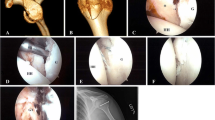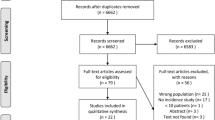Abstract
Purpose
Large Hill–Sachs lesions engaging the glenoid rim predispose to recurrent anterior instability and failure of isolated labrum repairs. In arthroscopic remplissage, the posterior capsule and infraspinatus are sutured into the humeral defect to limit such engagement. This systematic review assessed the outcomes and complications of arthroscopic remplissage for anterior shoulder instability.
Methods
A search of the MEDLINE, EMBASE and evidence-based medicine Cochrane databases was conducted. Data were extracted by two reviewers in a standardised manner. Redislocation, instability and complication rates were calculated and expressed as percentages with 95 % confidence intervals.
Results
Of 4,284 studies identified, eight articles with a total of 207 patients were analysed. Mean redislocation rate was 4.2 ± 3.9 % (range 0–15 %), and mean recurrent instability rate 3.2 ± 3.8 % (0–15 %). Posterosuperior shoulder pain and stiffness were the only complications described. Overall, there was a mean reduction in external rotation in adduction of 5.6° (−40 to +30), reduction in external rotation in abduction of 11.3° (−50 to +7) and reduction in internal rotation of 0.9 (−4 to 0) vertebral levels.
Conclusions
Arthroscopic remplissage alongside anterior labrum repair seems successful in treating recurrent shoulder instability in the presence of large or engaging Hill–Sachs lesion. However, the available literature consists mainly of heterogeneous case series. There is a need for a high-quality randomised trial to compare remplissage with other commonly used techniques for recurrent instability associated with substantial Hill–Sachs defects such as the Latarjet procedure.
Level of evidence
Systematic review, Level IV.

Similar content being viewed by others
References
Bankart ASB (1923) Recurrent or habitual dislocation of the shoulder-joint. Br Med J II:1132
Boileau P, O’Shea K, Vargas P, Pinedo M, Old J, Zumstein M (2012) Anatomical and functional results after arthroscopic Hill–Sachs remplissage. J Bone Joint Surg Am 94:618–626
Bollier MJ, Arciero R (2010) Management of glenoid and humeral bone loss. Sports Med Arthrosc 18:140–148
Burkhart SS, De Beer JF (2000) Traumatic glenohumeral bone defects and their relationship to failure of arthroscopic Bankart repairs: significance of the inverted-pear glenoid and the humeral engaging Hill–Sachs lesion. Arthroscopy 16:677–694
Deutsch AA, Kroll DG (2008) Decreased range of motion following arthroscopic remplissage. Orthopedics 31:492
Elser F, Dewing CB, Millett PJ (2008) Chondral and osteochondral lesions of the humerus: diagnosis and management. Oper Tech Sports Med 16:178–186
Franceschi F, Papalia R, Rizzello G, Franceschetti E, Del Buono A, Panascì M, Maffulli N, Denaro V (2012) Remplissage repair—new frontiers in the prevention of recurrent shoulder instability: a 2-year follow-up comparative study. Am J Sports Med 40:2462–2469
Garcia GH, Park MJ, Baldwin K, Fowler J, Kelly JD 4th, Tjoumakaris FP (2013) Comparison of arthroscopic osteochondral substitute grafting and remplissage for engaging Hill–Sachs lesions. Orthopedics 36:e38–e43
Giles JW, Elkinson I, Ferreira LM, Faber KJ, Boons H, Litchfield R, Johnson JA, Athwal GS (2012) Moderate to large engaging Hill–Sachs defects: an in vitro biomechanical comparison of the remplissage procedure, allograft humeral head reconstruction, and partial resurfacing arthroplasty. J Shoulder Elbow Surg 21:1142–1151
Haviv B, Mayo L, Biggs D (2011) Outcomes of arthroscopic “Remplissage”: capsulotenodesis of the engaging large Hill–Sachs lesion. J Orthop Surg Res 6:29
Koo SS, Burkhart SS, Ochoa E (2009) Arthroscopic double-pulley remplissage technique for engaging Hill–Sachs lesions in anterior shoulder instability repairs. Arthroscopy 25:1343–1348
Lynch JR, Clinton JM, Dewing CB, Warme WJ, Matsen FA 3rd (2009) Treatment of osseous defects associated with anterior shoulder instability. J Shoulder Elbow Surg 18:317–328
Nourissat G, Kilinc AS, Werther JR, Doursounian L (2011) A prospective, comparative, radiological, and clinical study of the influence of the ‘‘remplissage’’ procedure on shoulder range of motion after stabilization by arthroscopic Bankart repair. Am J Sports Med 39:2147–2152
Park MJ, Garcia G, Malhotra A, Major N, Tjoumakaris FP, Kelly JD (2012) The evaluation of arthroscopic remplissage by high-resolution magnetic resonance imaging. Am J Sports Med 40:2331–2336
Park MJ, Garcia G, Patel A, Tjoumakaris FP, Kelly JD 4th (2011) Arthroscopic remplissage with Bankart repair for the treatment of glenohumeral instability with Hill–Sachs defects. Arthroscopy 27:1187–1194
Petrera M, Patella V, Patella S, Theodoropoulos J (2010) A meta-analysis of open versus arthroscopic Bankart repair using suture anchors. Knee Surg Sports Traumatol Arthrosc 18:1742–1747
Pritchett JW, Clark JM (1987) Prosthetic replacement for chronic unreduced dislocations of the shoulder. Clin Orthop Relat Res 216:89–93
Pulavarti RS, Symes TH, Rangan A (2009) Surgical interventions for anterior shoulder instability in adults. Cochrane Database Syst Rev. doi:10.1002/14651858
Purchase RJ, Wolf EM, Hobgood RE, Pollock ME, Smalley CC (2008) Hill–Sachs “Remplissage”: an arthroscopic solution for the engaging Hill–Sachs lesion. Arthroscopy 24:723–726
Re P, Gallo RA, Richmond JC (2006) Transhumeral head plasty for large Hill–Sachs lesions. Arthroscopy 22:798-e1–798-e4
Slim K, Nini E, Forestier D, Kwiatkowski F, Panis Y, Chipponi J (2003) Methodological index for non-randomized studies (minors): development and validation of a new instrument. ANZ J Surg 73:712–716
Weber BG, Simpson LA, Hardegger F (1984) Rotational humeral osteotomy for recurrent anterior dislocation of the shoulder associated with a large Hill–Sachs lesion. J Bone Joint Surg Am 66:1443–1450
Zhu YM, Lu Y, Zhang J, Shen JW, Jiang CY (2011) Arthroscopic Bankart repair combined with remplissage technique for the treatment of anterior shoulder instability with engaging Hill–Sachs lesion: a report of 49 Cases with a minimum 2-year follow-up. Am J Sports Med 39:1640–1647
Conflict of interest
The authors declare that they have no conflict of interest.
Author information
Authors and Affiliations
Corresponding author
Rights and permissions
About this article
Cite this article
Rashid, M.S., Crichton, J., Butt, U. et al. Arthroscopic “Remplissage” for shoulder instability: a systematic review. Knee Surg Sports Traumatol Arthrosc 24, 578–584 (2016). https://doi.org/10.1007/s00167-014-2881-0
Received:
Accepted:
Published:
Issue Date:
DOI: https://doi.org/10.1007/s00167-014-2881-0




